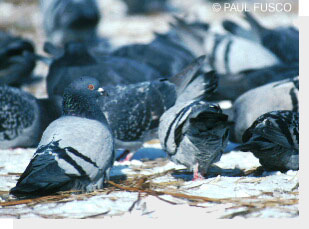Pigeon Nuisance Problems
Management of Nuisances: While some urban dwellers enjoy having friendly pigeons within sight, pigeons can be a nuisance, especially around roosting sites. Their acidic feces eat away gutters and other metal structures, erode stone buildings, and burn lawns. Pigeon droppings are also known to harbor a variety of diseases and parasites, and large accumulations may present a human health hazard. Precautionary measures such as wearing gloves, a dust mask, and washing with disinfecting soap during and after clean-up of pigeon droppings is highly recommended.
A number of options exist for managing or preventing nuisance situations involving pigeons:
Pigeon-proofing: Pigeons often prefer to use the interior portions of buildings to nest and roost if an opportunity for access is provided. Openings to lofts, steeples, vents, and eaves can be blocked with 1/2-inch galvanized wire mesh, wood, sheet metal, or other solid construction materials to prevent pigeons from entering.
Controlling pigeons on the exterior surfaces of buildings often requires considerably more effort. The most effective and permanent methods of control involve structural modifications which either physically exclude pigeons from the preferred surface or make it difficult for the birds to rest comfortably on the exposed building surfaces. Physical exclusion can be accomplished by installing weather resistant netting, wire screening, sheet metal, or other materials in a manner that will restrict access to the roosting sites. A grid of heavy gauge monofilament line spaced at six-inch intervals may also be used to create a fence that will interfere with the birds' normal flight pattern to the roosting area.
One of the most effective, although expensive methods for preventing roosting pigeons is the use of a commercially available bird barrier system consisting of a series of metal prongs or "porcupine wires" along a metal base that can be attached to a horizontal roosting surface. The needle-like strips of stainless steel act as a prickling fence to exclude birds permanently without harm.
Pigeons prefer to roost on level surfaces. Roosting areas can be modified to create a sloping surface, at a 60 degree incline or more, by installing wire mesh or other material to eliminate the level surfaces. There are also a number of non-toxic sticky substances registered as tactile repellents for bird control efforts. Birds tend to avoid landing upon treated areas but the effectiveness is usually lost over time.
Nest removal: Although time-consuming and unpleasant, removing nests will help depress populations. Nest destruction must be followed by pigeon-proofing the structure to achieve maximum population control.
Shooting: Feral pigeons are not protected by state or federal laws or regulations. Local municipal ordinances should be consulted prior to any control effort that will involve the discharge of firearms.
Toxicants: There is only one product registered for lethal control of pigeons in Connecticut and can only be used by a certified pest control operator under a special permit from DEEP Pesticides. The product is generally not appropriate or feasible for most nuisance situations experienced by the average homeowner.
Trapping: Pigeons may be live-trapped on buildings and other likely locations with permission of the property owner. A DEEP permit is issued without fee for the purpose of removing birds which are damaging structures or have become a nuisance. Live-traps for pigeons are available commercially from major trap suppliers. Pre-baiting the traps with grains that the birds are accustomed to will increase success. A variety of baits, including cracked corn, millet, popcorn, sunflower seeds, peas, bread, and peanuts can be used. Water should be available in the trap at all times. Trapping in any given area is usually slow, labor intensive, and only a temporary reduction measure.
Repellents: Acoustical and visual repellents are other means of reducing pigeon usage, but pigeons usually become accustomed quickly to these scare devices. Some homeowners have reported limited success using helium-filled eyespot balloons, predator (owl) decoys, and reflective mylar tape in roosting areas. The same limited success is achieved by the use of noise-making devices such as tape-recorded bird distress calls, firing of blank cartridges, and the use of propane-fired cannons in agricultural areas. Combining a number of techniques and frequent changes in the duration and location of the repellent may increase success.
Do you need additional help and advice concerning nuisance wildlife? Check out www.wildlifehelp.org and select "Connecticut" as your state to get started. WildlifeHelp.org is supported by the Northeast Association of Fish and Wildlife Agencies and the Northeast Wildlife Damage Management Cooperative.


